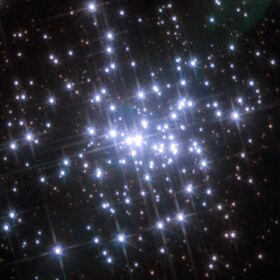Astronomy:NGC 3603-A1
| Observation data Epoch J2000.0 Equinox (celestial coordinates) | |
|---|---|
| Constellation | Carina |
| Right ascension | 11h 15m 07.305s[1] |
| Declination | −61° 15′ 38.43″[1] |
| Apparent magnitude (V) | 11.18[1] |
| Characteristics | |
| Spectral type | WN6h+WN6h[2] |
| B−V color index | 1.03[1] |
| Variable type | EA[3] |
| Astrometry | |
| Proper motion (μ) | RA: 2.4[4] mas/yr Dec.: 2.8[4] mas/yr |
| Distance | 7,600[2] pc |
| Absolute magnitude (MV) | −8.13[2] |
| Orbit[3] | |
| Primary | A1a |
| Companion | A2b |
| Period (P) | 3.7724 days |
| Eccentricity (e) | 0 |
| Inclination (i) | 71° |
| Semi-amplitude (K1) (primary) | 330 ± 20 km/s |
| Semi-amplitude (K2) (secondary) | 433 ± 53 km/s |
| Details | |
| A1a | |
| Mass | 120[2] M☉ |
| Radius | 29[2] R☉ |
| Luminosity | 2,500,000[2] L☉ |
| Temperature | 42,000[2] K |
| Age | 1.5[2] Myr |
| A1b | |
| Mass | 92[2] M☉ |
| Radius | 26[2] R☉ |
| Luminosity | 1,500,000[2] L☉ |
| Temperature | 40,000[2] K |
| Age | 1.5[2] Myr |
| Other designations | |
| Database references | |
| SIMBAD | data |
NGC 3603-A1 (HD 97950A1) is a double-eclipsing binary star system located at the centre of the HD 97950 cluster in the NGC 3603 star-forming region, about 25,000 light years from Earth. Both stars are of spectral type WN6h and among the most luminous and most massive known.
HD 97950 was catalogued as a star, but was known to be a dense cluster or close multiple star. In 1926, the six brightest members were given letters from A to F,[5] although several of them have since been resolved into more than one star.[6] Star A was first resolved into three components using speckle interferometry, although they can now be directly imaged using space-based or adaptive optics.[1] Component A1 was finally determined to be a spectroscopic binary.[7]

The two component stars of NGC 3603-A1 circle each other every 3.77 days, and show brightness variations of about 0.3 magnitudes due to eclipses. The stars orbit very close to each other, separated by barely their own diameters and at or near to filling their roche lobes.[7]
The masses of A1a and A1b determined from the orbital parameters are 116 ± 31 M☉ and 89 ± 16 M☉respectively.[3] This makes them the two most massive stars directly measured, i.e. with their masses determined (using Keplerian orbits), and not estimated from models. The masses estimated from analysis of the physical properties are slightly higher at 120 M☉ and 92 M☉.
Each component is a Wolf-Rayet (WR) star, with spectra dominated by strong broadened emission lines. Type WN6 indicates that ionised nitrogen lines are strong in comparison to ionised carbon lines, and the suffix h indicates that hydrogen is also seen in the spectrum. This type of WR star is not the classical stripped helium-burning aged star, but a young highly luminous object with CNO cycle fusion products showing at the surface due to strong conventional and rotational mixing, and high mass loss rates from the atmosphere. The emission lines are generated in the stellar wind and the photosphere is completely hidden. The surface fraction of hydrogen is still estimated to be 60-70%.[2]
Although the stars are very young, around 1.5 million years old, they have already lost a considerable fraction of their initial masses. The initial masses are estimated to have been 148 M☉ and 106 M☉, meaning they have lost 28 M☉ and 14 M☉ respectively.[2]
References
- ↑ 1.0 1.1 1.2 1.3 1.4 Melena, Nicholas W.; Massey, Philip; Morrell, Nidia I.; Zangari, Amanda M. (2008). "The Massive Star Content of NGC 3603". The Astronomical Journal 135 (3): 878–891. doi:10.1088/0004-6256/135/3/878. ISSN 0004-6256. Bibcode: 2008AJ....135..878M.
- ↑ 2.00 2.01 2.02 2.03 2.04 2.05 2.06 2.07 2.08 2.09 2.10 2.11 2.12 2.13 2.14 Crowther, P. A.; Schnurr, O.; Hirschi, R.; Yusof, N.; Parker, R. J.; Goodwin, S. P.; Kassim, H. A. (2010). "The R136 star cluster hosts several stars whose individual masses greatly exceed the accepted 150 M⊙ stellar mass limit". Monthly Notices of the Royal Astronomical Society 408 (2): 731–751. doi:10.1111/j.1365-2966.2010.17167.x. Bibcode: 2010MNRAS.408..731C.
- ↑ 3.0 3.1 3.2 Schnurr, O.; Casoli, J.; Chené, A. -N.; Moffat, A. F. J.; St-Louis, N. (2008). "The very massive binary NGC 3603-A1". Monthly Notices of the Royal Astronomical Society: Letters 389 (1): L38–L42. doi:10.1111/j.1745-3933.2008.00517.x. Bibcode: 2008MNRAS.389L..38S.
- ↑ 4.0 4.1 Zacharias, N. et al. (2004). "The Second U.S. Naval Observatory CCD Astrograph Catalog (UCAC2)". CDS/ADC Collection of Electronic Catalogues 1289 (5): 3043–3059. doi:10.1086/386353. Bibcode: 2003yCat.1289....0Z.
- ↑ Van Den Bos, W. H. (1928). "Another nebulous multiple star". Bulletin of the Astronomical Institutes of the Netherlands 4: 261. Bibcode: 1928BAN.....4..261V.
- ↑ Moffat, Anthony F. J.; Drissen, Laurent; Shara, Michael M. (1994). "NGC 3603 and its Wolf-Rayet stars: Galactic clone of R136 at the core of 30 Doradus, but without the massive surrounding cluster halo". Astrophysical Journal 436: 183. doi:10.1086/174891. Bibcode: 1994ApJ...436..183M.
- ↑ 7.0 7.1 7.2 Moffat, A. F. J.; Poitras, V.; Marchenko, S. V.; Shara, M. M.; Zurek, D. R.; Bergeron, E.; Antokhina, E. A. (2004). "Hubble Space TelescopeNICMOS Variability Study of Massive Stars in the Young Dense Galactic Starburst NGC 3603". The Astronomical Journal 128 (6): 2854–2861. doi:10.1086/425878. ISSN 0004-6256. Bibcode: 2004AJ....128.2854M.
External links
- NASA Astronomy Picture of the Day: Starburst Cluster in NGC 3603 (5 October 2007)
- NASA Image of the day
- Space Daily
 |


